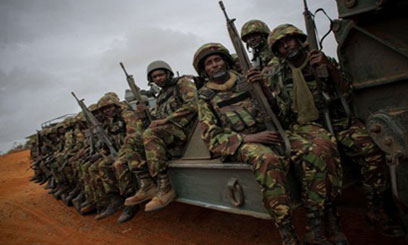Breast cancer is the second most common cancer among women in Sub-Saharan Africa, accounting for 16.8 percent of all female cancers. Central, West, and East Africa appear to have lower incidence rates than southern Africa, the latter estimated at 33.4 per 100,000. An estimated total of 48,600 cases occurred in Sub-Saharan Africa in 2002.
Worldwide, risk factors for female breast cancer include menstrual and reproductive factors, high body mass index (BMI), family history of breast cancer, and certain genetic mutations, including BRCA1/2. Other suggested risk factors include, to a much lesser extent, high alcohol consumption, contraceptive use, and the use of certain postmenopausal hormone replacement therapies. Reproductive and hormonal factors appear to be the most important, with risk being increased by early menarche, late menopause, late age at first birth, and low parity (Henderson, Ross, and Bernstein 1988).
Studies in Sub-Saharan Africa have also found reproductive and hormonal factors to be important, reporting increased risk with advanced age at first pregnancy and delivery, low parity, and late age at menarche (Adebamowo and Adekunle 1999; Coogan et al. 1996; Shapiro et al. 2000; Ssali, Gakwaya, and Katangole-Mbidde 1995).
In Sub-Saharan Africa, higher incidence rates and relative frequencies of breast cancer have been reported in association with urban than with rural residence (Oettlé and Higginson 1966; Schonland and Bradshaw 1968), but data are sparse. The incidence of breast cancer is much higher among white women in Africa than among black African women; for example, in Harare between 1993 and 1995, the incidence was 127.7 per 100,000 in whites and 20.4 in blacks (Chokunonga et al. 2000). These differences may be a reflection of the distribution of lifestyle factors thought to be important in the development of breast cancer, for example, low parity and high body mass.
Breast cancer risk has been associated with socioeconomic status, with women of higher social class (as measured by education, income, housing, and so forth) having a higher risk (Kogevinas et al. 1997). Once again, such differences are most likely a reflection of different prevalences of risk factors among social classes (for example, parity, age at menstruation and menopause, height, weight, alcohol consumption).
The effect of oral contraceptive hormones on the risk of breast cancer has been the subject of much research. There appears to be a small but detectable risk in women currently using oral contraceptives, but this diminishes when contraception ceases, and after 10 years, none of the excess risk remains (Reeves 1996). A case-control study in South Africa found that combined oral contraceptives may result in a small increase in risk, confined to women below the age of 25 years, but that injectable progesterone contraceptives did not increase risk (Shapiro et al. 2000).
Dietary fat appears to be correlated with the risk of breast cancer in interpopulation studies (Prentice and Sheppard 1990), but the association has been difficult to confirm in studies of individuals (Hunter et al. 1996). However, obesity in postmenopausal women has been identified as a risk factor in Europe (Bergstrom et al. 2001) as well as in Sub-Saharan Africa (Adebamowo and Adekunle 1999; Walker et al. 1989). Although traditional diets in Africa are typically low in animal products, especially fat, and high in fiber (Labadarios et al. 1996; Manning et al. 1971), this pattern is being modified by urbanization and Westernization of lifestyles, which may lead to an increase in breast cancer incidence in African populations. A case-control study in Cape Town did not find a protective effect of breastfeeding on breast cancer (Coogan et al. 1999). However, in a meta-analysis of 47 studies from 30 countries breastfeeding appears to be protective; based on a reanalysis of about 50,302 cases and 96,973 controls, two-thirds of the difference in rates between developed and developing countries were estimated to be attributed to breastfeeding (International Collaboration on HIV and Cancer 2002).
At least part of the familial risk of breast cancer is mediated through the major susceptibility genes BRCA1 and BRCA2 (about 2 percent of breast cancer cases in Europe). Very little is known of the prevalence of these mutations in African populations, although family history of breast cancer is also a risk factor in this setting (Rosenberg et al. 2002).
About 1 percent of all breast cancer cases occur in men, with the male-to-female ratio being higher in black and African populations than among white populations (Parkin et al. 2003; Sasco, Lowels, and Pasker de Jong 1993).
A review of the literature indicates a deficit of studies on breast cancer risk in Sub-Saharan Africa, and further research could be beneficial. As certain groups become more Westernized and urbanized, with associated changes in diet, later childbirth, and reduced parity and periods of breast-feeding, breast cancer incidence may increase. Public health campaigns should encourage breastfeeding unless there are good reasons not to (for example, HIV-infected mothers where milk powder and sterile water are freely available). There is no organized mammography screening program in Sub-Saharan Africa.
Mr. Bailey's 2nd Block IR-GSI Class blog focused on the current events of Sub-Saharan Africa
Sunday, October 21, 2012
Maize poses a health risk, study finds
A new French study conducted on the long-term health impacts of genetically
modified (GM) maize has found that the maize poses a threat to South African
consumers, the only consumers of GM in Africa.
Maize meal is South Africa's main staple food and consumed mostly by the black community. Results of the study were released internationally last week and they showed that GM Foods caused cancer and had serious impacts on liver and kidney functioning.
Conducted by French scientists, the study was released last week in France.
It was conducted on rats for two years. Genetically modified seeds are developed in a laboratory by inserting genes from another species into a crop.
The rats that were fed GM maize diet had a higher mortality rate of up to 50% of males, and 70% for females than those that were eating other types of food.
The study also reveals that at the beginning of the 24th month, 50% to 80% of females fed GM diets had developed tumours around the body, while male rats showed liver congestion.
Miriam Mayet, director of the African Centre for Biosafety in Johannesburg, said it was possible that many local brands were affected because 40% of maize is grown with a variety called NK603.
Countries such as Zimbabwe, Mexico and South Korea were reported to be unaware that they were importing the GM maize.
"Countries such as Swaziland and Mozambique know that they are buying GM maize from South Africa," Mayet said.
"GM maize is impossible to detect, because there is no labelling unless you test it."
She said SA was the only country where people consumed about 70% of genetically modified food. In other countries GM maize meal is not consumed by humans.
(COURTNEY D)
-
Maize meal is South Africa's main staple food and consumed mostly by the black community. Results of the study were released internationally last week and they showed that GM Foods caused cancer and had serious impacts on liver and kidney functioning.
Conducted by French scientists, the study was released last week in France.
It was conducted on rats for two years. Genetically modified seeds are developed in a laboratory by inserting genes from another species into a crop.
The rats that were fed GM maize diet had a higher mortality rate of up to 50% of males, and 70% for females than those that were eating other types of food.
The study also reveals that at the beginning of the 24th month, 50% to 80% of females fed GM diets had developed tumours around the body, while male rats showed liver congestion.
Miriam Mayet, director of the African Centre for Biosafety in Johannesburg, said it was possible that many local brands were affected because 40% of maize is grown with a variety called NK603.
Countries such as Zimbabwe, Mexico and South Korea were reported to be unaware that they were importing the GM maize.
"Countries such as Swaziland and Mozambique know that they are buying GM maize from South Africa," Mayet said.
"GM maize is impossible to detect, because there is no labelling unless you test it."
She said SA was the only country where people consumed about 70% of genetically modified food. In other countries GM maize meal is not consumed by humans.
(COURTNEY D)
-
Challenges for Breast Cancer in Swaziland
With October being International Breast Cancer Awareness Month it is the time the community is most focused on the disease and its effect in the community. In 2011, over 50 local Swazi women were diagnosed with the disease and two men from the 3000 consultations performed by Swaziland Breast and Cervical Cancer Network.
However, with many people in the population still not aware of the disease or not able to access screening due to their remote locations, the number of people living with the disease that have no diagnosis or care is much higher.
increase
It is for this reason that throughout the year and especially during October, SBCCN is working to constantly increase its awareness and fundraising activities.
“Breast Cancer affects more Swazis than many of us realise,” says Teresa Rehmeyer, Board Chair of SBCCN, “Sadly most patients diagnosed with the disease can only be offered surgery as treatment because opportunities for much needed chemotherapy in South Africa are limited. SBCCN is a not-for profit organisation, run predominantly by volunteers and to date it has not been funded by government or the Phalala fund (as was mistakenly stated in a recent article).
memory
“However, we are grateful for the assistance we receive from local businesses and individuals and from international development donors which allows us to bring awareness and diagnosis and support to those affected by breast cancer. We are also aiming to partner with other key stakeholders especially the ministry of health in the future to facilitate bringing other treatment options to Swaziland as soon as possible.”
SBCCN will be running its popular annual memorial walk up Sheba’s Breast in Mantenga Reserve on October 28. The walk is held in memory of Jane King, a founding member of SBCCN who passed away from the disease and also in recognition of all Swazi’s affected by the condition and Rehmeyer says “Brave the Breast 2012 will be a great day for many reasons, it brings awareness, prompts us to remember those lost to Breast Cancer, helps SBCCN raise vital finds to continue its work and it’s a chance to work on our own health and fitness alongside friends and family while enjoying the outdoors and the many give-away products donated generously by local companies!”
You can register for Brave the Breast by visiting the website: www.brave-the-breast.org or by visiting SBCCN’s office (3A PrintPak Building, Sheffield Rd Mbabane) or the SwaziTrails office at Mantenga Craft Centre. (COURTNEY D)
However, with many people in the population still not aware of the disease or not able to access screening due to their remote locations, the number of people living with the disease that have no diagnosis or care is much higher.
increase
It is for this reason that throughout the year and especially during October, SBCCN is working to constantly increase its awareness and fundraising activities.
“Breast Cancer affects more Swazis than many of us realise,” says Teresa Rehmeyer, Board Chair of SBCCN, “Sadly most patients diagnosed with the disease can only be offered surgery as treatment because opportunities for much needed chemotherapy in South Africa are limited. SBCCN is a not-for profit organisation, run predominantly by volunteers and to date it has not been funded by government or the Phalala fund (as was mistakenly stated in a recent article).
memory
“However, we are grateful for the assistance we receive from local businesses and individuals and from international development donors which allows us to bring awareness and diagnosis and support to those affected by breast cancer. We are also aiming to partner with other key stakeholders especially the ministry of health in the future to facilitate bringing other treatment options to Swaziland as soon as possible.”
SBCCN will be running its popular annual memorial walk up Sheba’s Breast in Mantenga Reserve on October 28. The walk is held in memory of Jane King, a founding member of SBCCN who passed away from the disease and also in recognition of all Swazi’s affected by the condition and Rehmeyer says “Brave the Breast 2012 will be a great day for many reasons, it brings awareness, prompts us to remember those lost to Breast Cancer, helps SBCCN raise vital finds to continue its work and it’s a chance to work on our own health and fitness alongside friends and family while enjoying the outdoors and the many give-away products donated generously by local companies!”
You can register for Brave the Breast by visiting the website: www.brave-the-breast.org or by visiting SBCCN’s office (3A PrintPak Building, Sheffield Rd Mbabane) or the SwaziTrails office at Mantenga Craft Centre. (COURTNEY D)
- Government Grants
- Unsecured business loans
- Law O
Wednesday, October 17, 2012
Uganda Blasts New Allegations of Helping Congo Rebels
Uganda is denouncing a leaked United Nations report that says both Uganda and Rwanda are supporting rebels in the eastern Democratic Republic of Congo — a charge both countries have denied.
Congo calls for embargo on Rwandan minerals
Congo accuses Rwanda of funding revolt in country's east
(Reuters) - The Democratic Republic of Congo is seeking an embargo on trade in minerals from Rwanda, which it accuses of funding a rebellion in the country's east, according to a letter written by the mines minister and seen by Reuters on Tuesday.
Six Indian UN troops hurt in clash on DR Congo-Uganda border
KINSHASA — Six Indian troops from the UN monitoring force in the Democratic Republic of Congo and their interpreter were wounded in an ambush in the conflict-ridden east of the country, a UN mission spokesman said Wednesday.
Uganda denies supporting Congo rebels
JOHANNESBURG (AP) — Ugandan officials on Wednesday dismissed allegations in a United Nations report that Uganda supports rebels in eastern Congo, saying the claims are intended to undermine efforts by regional leaders to stem violence in the central African country.
SWAZILAND: Swazi orphans face education crisis
mbabane, 29 April 2004 (IRIN) - Government and social welfare NGOs are seeking ways to offset a pending education crisis for orphans and vulnerable children (OVC) after school heads resolved this week to bar those unable to pay fees.
Education Minister Constance Simelane ordered school principals to admit OVC in January, and promised to provide for the orphans' fees. The directive was controversial, with some education authorities and media pundits doubting government's ability to find and expeditiously release funding for fees as well as other needs, like uniforms and textbooks.
Swazi schools are set to reopen in less than two weeks and heads have noted that the promised funds have not been forthcoming.
"Parents struggle to pay their children's fees, and it is unfair for them to assume the burden of orphans because government has not lived up to its commitments," said the Swaziland School Head Teachers Association in a statement.
The controversy highlights the challenge posed by Swaziland's growing population of children who have lost both parents to AIDS, as well as children considered to be at extreme health and social risk because of the illhealth of the family breadwinner.
"Government doesn't have the resources that are needed. It's a matter of making appeals to the international community, and using what funds we receive imaginatively," an official with the finance ministry told IRIN.
The head teachers' association noted that "as heads of schools we feel the ministry owes parents and the general public an explanation on the fact that there may not be enough money to cater for all OVCs".
A special Lilangeni 20 million (US $3 million) fund for OVC's educational needs was included in this year's government budget. Parliament has yet to pass the budget, but the finance minister is free to release the first quarter of the funds, Lilangeni 5 million (US $752,445), at his discretion.
"We are confident that monies will be available on time," Thandi Gama, an official with the National Emergency Response Committee on HIV/AIDS (NERCHA), told IRIN.
The head teachers also complained that government's allotment for OVCs was insufficient: Lilangeni 400 (US $60) per primary school pupil, and Lilangeni 1,500 (US $225) per secondary school pupil.
The school heads had understood that bursary amounts would depend on fees charged by particular schools, which at urban public schools can be twice that of rural schools, and four times as high in private secondary schools.
Education Minister Constance Simelane ordered school principals to admit OVC in January, and promised to provide for the orphans' fees. The directive was controversial, with some education authorities and media pundits doubting government's ability to find and expeditiously release funding for fees as well as other needs, like uniforms and textbooks.
Swazi schools are set to reopen in less than two weeks and heads have noted that the promised funds have not been forthcoming.
"Parents struggle to pay their children's fees, and it is unfair for them to assume the burden of orphans because government has not lived up to its commitments," said the Swaziland School Head Teachers Association in a statement.
The controversy highlights the challenge posed by Swaziland's growing population of children who have lost both parents to AIDS, as well as children considered to be at extreme health and social risk because of the illhealth of the family breadwinner.
"Government doesn't have the resources that are needed. It's a matter of making appeals to the international community, and using what funds we receive imaginatively," an official with the finance ministry told IRIN.
The head teachers' association noted that "as heads of schools we feel the ministry owes parents and the general public an explanation on the fact that there may not be enough money to cater for all OVCs".
A special Lilangeni 20 million (US $3 million) fund for OVC's educational needs was included in this year's government budget. Parliament has yet to pass the budget, but the finance minister is free to release the first quarter of the funds, Lilangeni 5 million (US $752,445), at his discretion.
"We are confident that monies will be available on time," Thandi Gama, an official with the National Emergency Response Committee on HIV/AIDS (NERCHA), told IRIN.
The head teachers also complained that government's allotment for OVCs was insufficient: Lilangeni 400 (US $60) per primary school pupil, and Lilangeni 1,500 (US $225) per secondary school pupil.
The school heads had understood that bursary amounts would depend on fees charged by particular schools, which at urban public schools can be twice that of rural schools, and four times as high in private secondary schools.
'Rwanda and Uganda have been supporting M23,' says UN report

© AFP
A UN report obtained by Reuters says that Uganda and Rwanda have continued to arm M23 rebels fighting a bloody insurgency in the Democratic Republic of Congo, despite repeated denials from both governments.
The U.N. Security Council’s Group of Experts said in a confidential report that Rwanda and Uganda - despite their strong denials - continued to support M23 rebels in their six-month fight against Congolese government troops in North Kivu province.
Ethnic violence leaves 30 dead in central Nigeria

Violence linked to an ongoing ethnic dispute over access to land has flared up again in central Nigeria, claiming the lives of at least 30 people, a governor's spokesman said on Wednesday. No arrests have been made.
"At least 30 people were confirmed killed," Cletus Akwaya, spokesman for the governor of Benue state, told AFP, saying herdsmen from the mainly Muslim Fulani ethnic group attacked a community of Tivs, who are mostly Christian, on Sunday and Monday.
He said no arrests had been made following the violence in the central town of Yogbo, which is near the border with neighbouring Nassarawa state.
Violence has flared numerous times in the area, with the dispute believed to be primarily over access to land. The Fulanis, who are mainly Muslim, are mostly herdsmen, while Tivs in the area tend to be Christian farmers.
Previous attempts to end the conflict have failed.
Nigeria's 160 million population includes some 250 ethnic groups and communal clashes break out regularly.(Ally Kennedy)
Kidnappers adbuct crew off Nigerian coast

Kidnappers have boarded a ship off Nigeria and abducted one Estonian and six Russian crew members, the French company Bourbon said Wednesday. Nine more crew members still remain on the Bourbon Liberty 249, heading for the Nigerien oil port of Onne.
"Bourbon confirms that seven crew members, six Russians and one Estonian, were kidnapped during the boarding of the Bourbon Liberty 249, which occurred on October 15, 2012 in Nigeria," a statement from the oil industry servicing firm said.
"The other nine crew members are still onboard the vessel which is heading for the Port of Onne. They are safe and sound, and in good health."
The statement did not give the location of the kidnapping, but Onne is located in the Niger Delta, the country's oil-producing region.
Scores of kidnappings for ransom have occurred in the Niger Delta, though a 2009 amnesty deal greatly reduced unrest there. (Ally Kennedy)
SWAZILAND: No money, no CD4 tests
MBABANE, 23 January 2012 (PlusNews) - Swaziland is still short of lab reagents needed for CD4 count testing, which is used to initiate and monitor patients on antiretroviral treatment, and HIV-positive people are growing increasingly frustrated as the country enters its fourth month without a way to establish the strength of their immune system.
“This is setting us back years in the way we treat people living with HIV and AIDS. Government says it has no money to buy the chemicals needed to determine CD4 counts,” Thembi Nkambule, director of the Swaziland Network of People Living with HIV and AIDS (SWANEPHA), an umbrella organization for the country’s HIV and AIDS support groups, told IRIN/Plus News.
Deciding on when to start a patient on ARV drugs is usually based on a combination of CD4 cell count test results and HIV disease progression, which the World Health Organization (WHO) has defined according to four clinical stages, with stage four being AIDS. In addition, guidelines for managing patients on ARV therapy also use CD4 count testing to measure the impact of the medication on the patient's health.
The government’s ongoing financial crisis again hit the health sector in October 2011 when supplies of lab reagents - the chemicals needed to operate the CD4 count apparatus - began drying up. Since December, CD4 count testing has virtually ground to a halt in Swaziland, which has the world's highest HIV prevalence.
Shortages of HIV programme supplies in Swaziland were first reported in mid-2011. Although the stock-outs have been largely blamed on reduced revenues from the Southern African Customs Union (SACU), the country also opted not to apply for funding in Round 10 from the Global Fund to Fight AIDS, TB and Malaria. Instead, it chose to assume financial responsibility for HIV treatment itself, at a time when SACU revenues were already expected to decline.
Health Minister Themba Xaba said in a statement, “We need R7 million [US$875,000] to purchase the CD4 machine reagents, which is a lot of money. This, however, does not mean that patients are not getting any treatment. There are clinical stages and guidelines that are used.”
In the absence of a CD4 count test, guidelines suggest that patients at stage three or four, determined by observable symptoms defined by the WHO, should be started on ARVs.
“Doctors can only go by how a patient tells them he or she is feeling, or if there are symptoms. The problem is that many people with HIV do not get sick or have physical symptoms while their CD4 counts are dropping to the level where they must take ARVs,” said Nkambule.
“Not having accurate information on CD4 counts puts the doctor in the same position as performing surgery blindfolded."
According to Nkambule, equipment for monitoring liver and kidney function is also out of order. “When government ran out of money we were promised by government that the health sector would not be compromised," he added.
The health ministry is looking to the Ministry of Finance to come up with the necessary funding. Xaba has advised HIV-positive people to have their CD4 tests conducted at private labs. However, the test costs R150 ($19), which is unaffordable in a country where 70 percent of the population live below the poverty line.
“For many of us coming up with bus fare to the clinic is a big challenge. Taking CD4 tests is not a one-off thing. Many tests are required. I would say few people are going to private doctors for these tests,” said Mandla Tsela, an AIDS testing and counselling officer in Manzini.
AIDS groups have criticized the constant uncertainty: in 2011, the country also experienced ARV stock-outs and had to be bailed out by the US President's Emergency Plan for AIDS Relief (PEPFAR), which gave the country $7 million in emergency funding in August. Swaziland now has a buffer stock of first-line ARVs that should last until April 2012.
“Why does there have to be a crisis or something has to break down before any action is taken? First the people living with HIV and AIDS were put at risk because of the supply of ARVs, and now we don’t know really who should be on treatment because they don’t have their CD4 counts,” Nkambule said.
(courtney d)
“This is setting us back years in the way we treat people living with HIV and AIDS. Government says it has no money to buy the chemicals needed to determine CD4 counts,” Thembi Nkambule, director of the Swaziland Network of People Living with HIV and AIDS (SWANEPHA), an umbrella organization for the country’s HIV and AIDS support groups, told IRIN/Plus News.
Deciding on when to start a patient on ARV drugs is usually based on a combination of CD4 cell count test results and HIV disease progression, which the World Health Organization (WHO) has defined according to four clinical stages, with stage four being AIDS. In addition, guidelines for managing patients on ARV therapy also use CD4 count testing to measure the impact of the medication on the patient's health.
The government’s ongoing financial crisis again hit the health sector in October 2011 when supplies of lab reagents - the chemicals needed to operate the CD4 count apparatus - began drying up. Since December, CD4 count testing has virtually ground to a halt in Swaziland, which has the world's highest HIV prevalence.
Shortages of HIV programme supplies in Swaziland were first reported in mid-2011. Although the stock-outs have been largely blamed on reduced revenues from the Southern African Customs Union (SACU), the country also opted not to apply for funding in Round 10 from the Global Fund to Fight AIDS, TB and Malaria. Instead, it chose to assume financial responsibility for HIV treatment itself, at a time when SACU revenues were already expected to decline.
Health Minister Themba Xaba said in a statement, “We need R7 million [US$875,000] to purchase the CD4 machine reagents, which is a lot of money. This, however, does not mean that patients are not getting any treatment. There are clinical stages and guidelines that are used.”
In the absence of a CD4 count test, guidelines suggest that patients at stage three or four, determined by observable symptoms defined by the WHO, should be started on ARVs.
“Doctors can only go by how a patient tells them he or she is feeling, or if there are symptoms. The problem is that many people with HIV do not get sick or have physical symptoms while their CD4 counts are dropping to the level where they must take ARVs,” said Nkambule.
“Not having accurate information on CD4 counts puts the doctor in the same position as performing surgery blindfolded."
According to Nkambule, equipment for monitoring liver and kidney function is also out of order. “When government ran out of money we were promised by government that the health sector would not be compromised," he added.
The health ministry is looking to the Ministry of Finance to come up with the necessary funding. Xaba has advised HIV-positive people to have their CD4 tests conducted at private labs. However, the test costs R150 ($19), which is unaffordable in a country where 70 percent of the population live below the poverty line.
| Read more |
AIDS groups have criticized the constant uncertainty: in 2011, the country also experienced ARV stock-outs and had to be bailed out by the US President's Emergency Plan for AIDS Relief (PEPFAR), which gave the country $7 million in emergency funding in August. Swaziland now has a buffer stock of first-line ARVs that should last until April 2012.
“Why does there have to be a crisis or something has to break down before any action is taken? First the people living with HIV and AIDS were put at risk because of the supply of ARVs, and now we don’t know really who should be on treatment because they don’t have their CD4 counts,” Nkambule said.
(courtney d)
Swaziland: HIV+ patients in a dilemma
Many HIV positive patients in the country cannot have their CD4 count checked as there are still no analyser machine reagents in the country’s hospitals.
This is because government lacaks E7 million to purchase them, it has since been gathered.Reagents are chemicals used to process the blood so that the machines can count the CD4 cells. This has left many HIV/AIDS patients frustrated as they do not know how healthy they are in terms of their CD4 count.
Since early December 2011, knowing one’s CD4 count has only been available for patients who can afford the E100 to E150 charged by private laboratories.
This publication paid a visit to Lamvelase Health Centre, where patients were told to go to Lancet or the Summerplace building, which are private laboratories, to have their CD4 counts checked.
“I have travelled all the way from kaPhunga to have my CD4 count checked, only to find that the machines are faulty. To make matters worse, I do not even have the money to go to the private clinics where I could get help,” one of the patients, Patience* said.
Mehluli* said he could not afford going to Lancet and would go back home.
This is because government lacaks E7 million to purchase them, it has since been gathered.Reagents are chemicals used to process the blood so that the machines can count the CD4 cells. This has left many HIV/AIDS patients frustrated as they do not know how healthy they are in terms of their CD4 count.
Since early December 2011, knowing one’s CD4 count has only been available for patients who can afford the E100 to E150 charged by private laboratories.
This publication paid a visit to Lamvelase Health Centre, where patients were told to go to Lancet or the Summerplace building, which are private laboratories, to have their CD4 counts checked.
“I have travelled all the way from kaPhunga to have my CD4 count checked, only to find that the machines are faulty. To make matters worse, I do not even have the money to go to the private clinics where I could get help,” one of the patients, Patience* said.
Mehluli* said he could not afford going to Lancet and would go back home.
Rhino poaching hits record numbers in South Africa
By the CNN Wire Staff
updated 9:16 AM EDT, Wed October 17, 2012
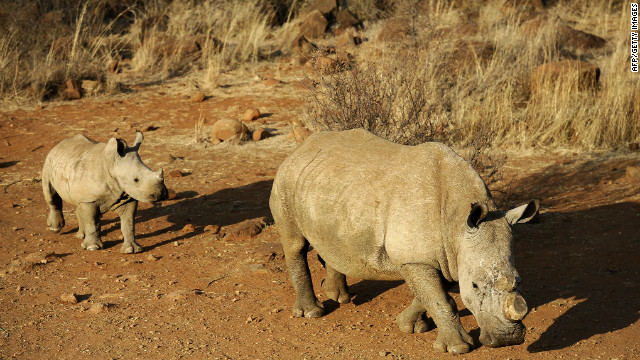
So far, 455 African rhinos have been killed this year for their horns based on a belief that they can cure cancer.
STORY HIGHLIGHTS
- So far, 455 African rhinos have been killed this year, officials say
- The number surpasses last year's killings
- "It is critical for the South African government to engage with consumer countries," expert says
An unsubstantiated belief on their healing powers is spreading in southeast Asia, sending clients paying top dollar for traditional cures, officials said.
So far, 455 African rhinos have been killed this year, according to government officials. A total of 448 rhinos were killed last year.
"It is critical for the South African government to engage with consumer countries and to fight against international syndicates involved in illegal rhino horn trade," said Dr. Jo Shaw, rhino coordinator for the WWF in South Africa.
ar against rhino poaching
One of the nations linked to the trade is Vietnam and a collaboration action between the two against illegal rhino horn trade remains unsigned, according to Shaw.
"There is also an urgent need for law enforcement actions by neighboring countries implicated as transit routes for illegal trade in rhino horn," the coordinator said.
Conservation group Save the Rhino estimates that there are 25,000 rhinos in Africa. Of those, about 21,000 live in South Africa, the group says.
"Rhino numbers continue to grow in South Africa as more rhinos are being born than are dying, even when poaching mortalities are taken into account," Shaw said. "However, we are approaching the critical tipping point where rhino numbers go into decline and would undermine conservation efforts."
South African officials say they have arrested nearly 200 people linked to the trade, including about 20 who allegedly serve as couriers.
(Ally Kennedy)
Swaziland's HIV/Aids Crisis
Tuesday, October 16, 2012
Kenyan police post targeted, al Shabaab suspected
GARISSA, Kenya (Reuters) - Suspected al Shabaab militants threw a hand grenade at a Kenyan police post on Monday in the northern town of Garissa close to the border with Somalia, police said, a day after two police officers were shot dead in the same town.
Kenya
has been rocked by a series of grenade and gun attacks since it sent
troops into Somalia last October in pursuit of Islamist al Shabaab
rebels whom it blamed for kidnapping its security personnel and Western
tourists.
"A hand grenade was thrown, it dropped and exploded but nobody was injured," Garissa county commissioner Mohamed Maalim said, adding a gunfight ensued for about 10 minutes.
"The police fought back, secured the post and repulsed the gang," he said.
Maalim said police
suspected it was an al Shabaab attack, the third in two days, which
follows the killing of two policemen in Garissa and a separate bombing
in which three children attending a Sunday school were hurt when
militants threw a hand grenade at a church in Nairobi.
The attacks on
Kenyan soil have intensified since Kenyan troops, alongside other
African Union forces, launched an offensive against the southern Somali
port of Kismayu, al Shabaab's last stronghold, forcing the rebels to
flee.
"This is a heinous
act by al Shabaab. They are out to cause chaos out of bitterness from
their losses in Somalia," Maalim said. Security sources said police and
paramilitary forces were searching for the gunmen.
Most of the
inhabitants of Garissa are ethnic Somalis. The town is 180 km (110
miles) from Kenya's border with Somalia.
In July masked
assailants launched simultaneous gun and grenade raids on two churches
in Garissa, killing at least 17 people in the worst attack in the
country since Kenya sent troops into Somalia.
Local residents say tension is running high after the latest attack on police.
"Security officers
are going from house to house, breaking into homes and roughing people
up," said Mohammed Gabow, former Mayor of Garissa, who is now an elected
civic leader in Bulla Iftin, where the police post is located.
(posted by Courtney Morgan)
Kenya's Military Has Proven Its Might in Somalia
Nairobi — "Ukiona simba amenyeshewa mvua, usifikiri ni paka (If you
see a lion that's been soaked in rain, do not mistake it for a cat) -
these are the words Kenya's military chief General Julius Karangi chose
to use on Tuesday to describe his gallant soldiers fighting in Somalia.
"Everyone who thought we are just an occupational force has seen for themselves," Karangi said, admitting: "We had been taken for granted for long."
The Kenyan soldiers have been praised both locally and internationally - but the most touching praise came from school children who sent them handwritten poems penned on July 30 and delivered to the KDF headquarters on Tuesday.
"When David went to face Goliath, he went unarmed. He was only a small boy who came out victorious," Cecilia of Our Lady of Mercy Secondary School said in one of the poems to be delivered to the soldiers who are still celebrating the capture of Kismayu, a stronghold of the militant group which had wrecked havoc in Kenya before the soldiers drove them away.
Another letter written by Joy prayed for the soldiers' safety saying "Nevertheless, we hope you all come back safe and sound and unharmed."
At least 3,000 of the militants have been killed since the security operation targeting them started a year ago - many of them shot in the battlefield where they sought to protect their territories before KDF overpowered their rag tag command.
"Today we occupy no less than 200,000 sq kilometres previously controlled by those bad fellows," General Karangi boasted, in his first public address since his forces captured Kismayu.
He said KDF was now "in full control of various key regions where the Al Shabaab used to transact up to $100,000 daily in illegal fees. This are areas like Afmadow."
"We have restored business in these areas," General Karangi said and urged the Somali government to consolidate power to be able to take over control of their country.
He is confident the AMISOM mandate which comes to an end at the end of October will be extended to enable them complete their task.
Defence Minister Yusuf Haji said the Kenyan soldiers "will not stay in Somalia an extra day, once their mission is completed."
African Union troops alongside Somali forces continue to seize more towns in Somalia, the latest being the formerly Islamist-held town of Wanla Weyn which fell on Sunday, the latest loss for the Al-Qaeda linked Shabaab fighters.
Its capture - reportedly without a fight - is a key step towards opening up the main highway linking the capital Mogadishu to Baidoa, a major town wrested from the Shabaab by Ethiopian troops in February.
The AU mission in Somalia which also seized the Balli Doogle airstrip on Sunday, has now advanced over 90 kilometres (55 miles) northwest from Mogadishu since launching an offensive outside the city in May.
"Somali government forces with the support of AMISOM troops have secured the strategic town of Wanla Weyn on the Afgoye-to-Baidoa corridor," said Andrew Gutti, commander of the 17,000-strong AMISOM force.
Wanla Weyn lies roughly a third of the way to Baidoa from Mogadishu, with the remaining 160 kilometres (100 miles) still controlled by the Shabaab.
"The capture of this town denies Al Shabaab another source of illegal income after a string of defeats," Gutti added in a statement.
"It will also facilitate the provision of much-needed humanitarian assistance to the local population."
Kenyan troops - who invaded Somalia a year ago before later integrating into AMISOM - are also pushing up from the south, having last week seized the Shabaab bastion and major port of Kismayu.
The hard-line insurgents still control the town of Jowhar, some 80 kilometres northeast of Mogadishu, and the small port town of Barawe, lying some 180 kilometres down the coast from the capital.
(published by Courtney Morgan)
"Everyone who thought we are just an occupational force has seen for themselves," Karangi said, admitting: "We had been taken for granted for long."
The Kenyan soldiers have been praised both locally and internationally - but the most touching praise came from school children who sent them handwritten poems penned on July 30 and delivered to the KDF headquarters on Tuesday.
"When David went to face Goliath, he went unarmed. He was only a small boy who came out victorious," Cecilia of Our Lady of Mercy Secondary School said in one of the poems to be delivered to the soldiers who are still celebrating the capture of Kismayu, a stronghold of the militant group which had wrecked havoc in Kenya before the soldiers drove them away.
Another letter written by Joy prayed for the soldiers' safety saying "Nevertheless, we hope you all come back safe and sound and unharmed."
At least 3,000 of the militants have been killed since the security operation targeting them started a year ago - many of them shot in the battlefield where they sought to protect their territories before KDF overpowered their rag tag command.
"Today we occupy no less than 200,000 sq kilometres previously controlled by those bad fellows," General Karangi boasted, in his first public address since his forces captured Kismayu.
He said KDF was now "in full control of various key regions where the Al Shabaab used to transact up to $100,000 daily in illegal fees. This are areas like Afmadow."
"We have restored business in these areas," General Karangi said and urged the Somali government to consolidate power to be able to take over control of their country.
He is confident the AMISOM mandate which comes to an end at the end of October will be extended to enable them complete their task.
Defence Minister Yusuf Haji said the Kenyan soldiers "will not stay in Somalia an extra day, once their mission is completed."
African Union troops alongside Somali forces continue to seize more towns in Somalia, the latest being the formerly Islamist-held town of Wanla Weyn which fell on Sunday, the latest loss for the Al-Qaeda linked Shabaab fighters.
Its capture - reportedly without a fight - is a key step towards opening up the main highway linking the capital Mogadishu to Baidoa, a major town wrested from the Shabaab by Ethiopian troops in February.
The AU mission in Somalia which also seized the Balli Doogle airstrip on Sunday, has now advanced over 90 kilometres (55 miles) northwest from Mogadishu since launching an offensive outside the city in May.
"Somali government forces with the support of AMISOM troops have secured the strategic town of Wanla Weyn on the Afgoye-to-Baidoa corridor," said Andrew Gutti, commander of the 17,000-strong AMISOM force.
Wanla Weyn lies roughly a third of the way to Baidoa from Mogadishu, with the remaining 160 kilometres (100 miles) still controlled by the Shabaab.
"The capture of this town denies Al Shabaab another source of illegal income after a string of defeats," Gutti added in a statement.
"It will also facilitate the provision of much-needed humanitarian assistance to the local population."
Kenyan troops - who invaded Somalia a year ago before later integrating into AMISOM - are also pushing up from the south, having last week seized the Shabaab bastion and major port of Kismayu.
The hard-line insurgents still control the town of Jowhar, some 80 kilometres northeast of Mogadishu, and the small port town of Barawe, lying some 180 kilometres down the coast from the capital.
(published by Courtney Morgan)
Kenya: Defence Forces Kill 3,000 Al Shabaab in One Year
Kenya Defence Forces have killed over 3,000 al Shabaab militia during
combat since October last year when they entered war ravaged Somalia in
pursuit of the al Qaeda linked insurgents.
Defence Minister Yusuf Haji yesterday revealed that over 3,000 fighters had been killed and assorted weapons and gun mounted vehicles destroyed or captured during the year long operation.
KDF has lost 22 soldiers and officers, as well as a helicopter during the one year it has been in Somalia. It will mark its first anniversary in Somalia on Sunday, October 14.
"It is worth mentioning that to be a peacekeeper is a sacrifice a soldier has to make on behalf of the international community, his country and the military. During this operation, the enemy has lost over 3,000 militants not to mention the assorted arms and technicals (vehicles) that have been captured," Haji said.
He was speaking during a ceremony by Brand Kenya where school children around the country presented 5,000 patriotic and encouragement letters and messages of goodwill to KDF soldiers fighting in Somalia.
President Kibaki yesterday called for the demobilization, disarmament and reintegration of the al Shabaab insurgents surrendering to the African Union Mission in Somalia (Amisom) forces.
Speaking in Kampala, Uganda, when he held bilateral talks with President Hassan Sheikh Mohamud of Somalia, the Head of State noted that as part of the reconstruction of Somalia, there is need to take urgent measures to disarm those surrendering so as to avoid regrouping of the same.
At the same time President Kibaki reassured the Somalia leadership and its citizens that Kenya has no ulterior motive but its ultimate desire is to see Somalia return to peace and stability.
"In carrying out the stabilization efforts, I would wish to assure your Excellency that Kenya has no other agenda and its only desire is to see Somalia return to peace and stability," said the President.
He called for extension of KDF's Amisom mandate in Somalia that expires at the end of this month. Haji yesterday thanked the Chief of General Staff General Julius Karangi for his leadership which he said had allowed KDF to make an unparalleled historic achievement in contemporary African military.
Haji said that by defeating al Shabaab, KDF has proved to the world that the Kenyan military is a professional outfit with the ability to keep peace in the region and the world.
"The achievement of the KDF, by defeating an al Qaeda-linked militant outfit in Kismayu is no mean achievement. We have indeed proved to the world our professional skill and ability. KDF have made us proud and proved to the the world that Kenya continues to flex her muscles as a regional military worth its profession," the Defence minister said.
Haji did not talk about an incident on 24 October in which a KDF soldier is reported to have opened fire on a group of unarmed Somali civilians 50 kilometres from the port city of Kismayu. KDF at the time condemned the incident and said the soldier had been arrested and would be prosecuted.
Haji yesterday warned that while al Shabaab is no longer in control of southern Somalia, the group is still dangerous because it has ceased being a viable political alternative to the Somalia government but is moving back to to being a local insurgency.
"Amisom will have to adapt its tactics to respond to this new change in battle space and it will have to be more effective at protecting crucial trade routes from kidnappers and bandits. Our government and the people of Kenya have sacrificed their lives and resources to liberate Somalia fro al Shabaab and we assure the people of Somalia we shall stand with them at all times," Haji said.
He appealed to Somali nationals to unite and consolidate on on the gains made in the peaceful elections of MPs, Speaker and President and bring lasting peace to the war torn country.
Chief of General Staff Gen Julius Karangi said that Kenya has liberated over 200,000 square kilometres of Somalia that had previously been under the control of Al Shabaab and destroyed their structures.
He said that KDF has now started offering humanitarian aid to suffering population in Somalia and have so far drilled two boreholes in Badhadhe and Gerille and rehabilitated two others in Jana Cabdalla apart from offering medical assistance.
"We have destroyed their facilities and captured their economic facilities like money transfer in Afmadhow which transacted over 100,000 US dollars in a month.
KDF is not an occupations force. It was only interested in routing out al Shabaab who were masquerading as a religious group. They had taken us for granted and took advantage to attack us," the CDF said.
(published by Courtney Morgan)
Defence Minister Yusuf Haji yesterday revealed that over 3,000 fighters had been killed and assorted weapons and gun mounted vehicles destroyed or captured during the year long operation.
KDF has lost 22 soldiers and officers, as well as a helicopter during the one year it has been in Somalia. It will mark its first anniversary in Somalia on Sunday, October 14.
"It is worth mentioning that to be a peacekeeper is a sacrifice a soldier has to make on behalf of the international community, his country and the military. During this operation, the enemy has lost over 3,000 militants not to mention the assorted arms and technicals (vehicles) that have been captured," Haji said.
He was speaking during a ceremony by Brand Kenya where school children around the country presented 5,000 patriotic and encouragement letters and messages of goodwill to KDF soldiers fighting in Somalia.
President Kibaki yesterday called for the demobilization, disarmament and reintegration of the al Shabaab insurgents surrendering to the African Union Mission in Somalia (Amisom) forces.
Speaking in Kampala, Uganda, when he held bilateral talks with President Hassan Sheikh Mohamud of Somalia, the Head of State noted that as part of the reconstruction of Somalia, there is need to take urgent measures to disarm those surrendering so as to avoid regrouping of the same.
At the same time President Kibaki reassured the Somalia leadership and its citizens that Kenya has no ulterior motive but its ultimate desire is to see Somalia return to peace and stability.
"In carrying out the stabilization efforts, I would wish to assure your Excellency that Kenya has no other agenda and its only desire is to see Somalia return to peace and stability," said the President.
He called for extension of KDF's Amisom mandate in Somalia that expires at the end of this month. Haji yesterday thanked the Chief of General Staff General Julius Karangi for his leadership which he said had allowed KDF to make an unparalleled historic achievement in contemporary African military.
Haji said that by defeating al Shabaab, KDF has proved to the world that the Kenyan military is a professional outfit with the ability to keep peace in the region and the world.
"The achievement of the KDF, by defeating an al Qaeda-linked militant outfit in Kismayu is no mean achievement. We have indeed proved to the world our professional skill and ability. KDF have made us proud and proved to the the world that Kenya continues to flex her muscles as a regional military worth its profession," the Defence minister said.
Haji did not talk about an incident on 24 October in which a KDF soldier is reported to have opened fire on a group of unarmed Somali civilians 50 kilometres from the port city of Kismayu. KDF at the time condemned the incident and said the soldier had been arrested and would be prosecuted.
Haji yesterday warned that while al Shabaab is no longer in control of southern Somalia, the group is still dangerous because it has ceased being a viable political alternative to the Somalia government but is moving back to to being a local insurgency.
"Amisom will have to adapt its tactics to respond to this new change in battle space and it will have to be more effective at protecting crucial trade routes from kidnappers and bandits. Our government and the people of Kenya have sacrificed their lives and resources to liberate Somalia fro al Shabaab and we assure the people of Somalia we shall stand with them at all times," Haji said.
He appealed to Somali nationals to unite and consolidate on on the gains made in the peaceful elections of MPs, Speaker and President and bring lasting peace to the war torn country.
Chief of General Staff Gen Julius Karangi said that Kenya has liberated over 200,000 square kilometres of Somalia that had previously been under the control of Al Shabaab and destroyed their structures.
He said that KDF has now started offering humanitarian aid to suffering population in Somalia and have so far drilled two boreholes in Badhadhe and Gerille and rehabilitated two others in Jana Cabdalla apart from offering medical assistance.
"We have destroyed their facilities and captured their economic facilities like money transfer in Afmadhow which transacted over 100,000 US dollars in a month.
KDF is not an occupations force. It was only interested in routing out al Shabaab who were masquerading as a religious group. They had taken us for granted and took advantage to attack us," the CDF said.
(published by Courtney Morgan)
Kenya: President Calls For Al Shabaab to Surrender
Kampala — President Mwai Kibaki has called for the demobilisation,
disarmament and reintegration of the Al-Shabaab insurgents surrendering
to the AMISOM forces.
Speaking on Tuesday in Kampala, Uganda, when he held bilateral talks with President Hassan Sheikh Mohamud of Somalia, the Head of State noted that as part of the reconstruction of Somalia, there is need to take urgent measures to disarm those surrendering to avoid any regrouping.
At the same time President Kibaki reassured the Somalia leadership and its citizens that Kenya has no ulterior motive but its ultimate desire is to see the Horn of Africa nation return to peace and stability.
Said the President: "In carrying out the stabilisation efforts, I would wish to assure your Excellency that Kenya has no other agenda and its only desire is to see Somalia return to peace and stability."
The president noted that under the auspices of IGAD, Kenya is involved in the stabilisation of South Central Somalia and its desire is to work hand in hand with the Somalia government to achieve this goal to create a conducive and stable environment for the return of internally displaced persons and refugees to the pacified areas.
President Kibaki also called for the extension of the mandate of AMISOM which expires at the end of this month in order to consolidate the gains made so far against extremist elements.
The Head of State further reiterated Kenya's commitment in lobbying for and mobilising international support for Somalia.
"We are in this regard willing to host an international donors' conference for Somalia."
President Kibaki commended the people of Somalia for the peaceful transition which culminated in the election of Sheikh Mohamud as the Head of the Federal Republic of Somalia.
He pledged Kenya's support to the new leadership of Somalia and its government as they embark in the rebuilding of their nation.
President Kibaki said Kenya is ready to extend any possible assistance towards addressing the priority areas identified by the Somalia Government noting that this process can be undertaken through the frame work provided by the Joint Commission for Cooperation.
He further said the Government of Kenya is willing to support capacity building for the Somalia security forces and civil service as well as other training initiatives identified by the Somalia Government.
On his part the Somali President expressed gratitude to Kenya for continued support towards stabilization of his country.
He said he looked forward to further support in the importance phase of the reconstruction of the war-torn nation.
(published by Courtney Morgan)
Speaking on Tuesday in Kampala, Uganda, when he held bilateral talks with President Hassan Sheikh Mohamud of Somalia, the Head of State noted that as part of the reconstruction of Somalia, there is need to take urgent measures to disarm those surrendering to avoid any regrouping.
At the same time President Kibaki reassured the Somalia leadership and its citizens that Kenya has no ulterior motive but its ultimate desire is to see the Horn of Africa nation return to peace and stability.
Said the President: "In carrying out the stabilisation efforts, I would wish to assure your Excellency that Kenya has no other agenda and its only desire is to see Somalia return to peace and stability."
The president noted that under the auspices of IGAD, Kenya is involved in the stabilisation of South Central Somalia and its desire is to work hand in hand with the Somalia government to achieve this goal to create a conducive and stable environment for the return of internally displaced persons and refugees to the pacified areas.
President Kibaki also called for the extension of the mandate of AMISOM which expires at the end of this month in order to consolidate the gains made so far against extremist elements.
The Head of State further reiterated Kenya's commitment in lobbying for and mobilising international support for Somalia.
"We are in this regard willing to host an international donors' conference for Somalia."
President Kibaki commended the people of Somalia for the peaceful transition which culminated in the election of Sheikh Mohamud as the Head of the Federal Republic of Somalia.
He pledged Kenya's support to the new leadership of Somalia and its government as they embark in the rebuilding of their nation.
President Kibaki said Kenya is ready to extend any possible assistance towards addressing the priority areas identified by the Somalia Government noting that this process can be undertaken through the frame work provided by the Joint Commission for Cooperation.
He further said the Government of Kenya is willing to support capacity building for the Somalia security forces and civil service as well as other training initiatives identified by the Somalia Government.
On his part the Somali President expressed gratitude to Kenya for continued support towards stabilization of his country.
He said he looked forward to further support in the importance phase of the reconstruction of the war-torn nation.
(published by Courtney Morgan)
Monday, October 8, 2012
A sub-Saharan spring?
North Africa’s spirit of protest will spread south
Nov 17th 2011 | from The World In 2012 print edition
The successful uprisings of 2011 in north Africa were closely watched farther south on the continent. They have already spawned some local protest movements—as in Burkina Faso—and are inspiring talk of more. Authoritarian rulers in sub-Saharan Africa can expect a year of growing opposition and attempts to dethrone them. The dynamics are likely to be somewhat different from those on the Mediterranean shore, where protesters were richer and better informed. The protest bug is catching, nonetheless. In places like Uganda, the downtrodden are hailing the liberators of Tunis, Tripoli and Cairo as role models, creating cross-African political connections rarely seen in recent decades.
As in north Africa, mobile communication and social media are popular on the rest of the continent, and not just in rich enclaves. More than 1m Nigerians have a BlackBerry. Africa as a whole has more mobile
Related topics
Ripe for rebellionAngola and Equatorial Guinea are prime examples. Both are ruled by resource-peddling strongmen—each in power for 32 years, making them Africa's longest-serving leaders since the ousting and killing of Muammar Qaddafi in Libya after 41 years. They are the second- and fourth-biggest oil producers in sub-Saharan Africa. Yet most people there live on less than $1 a day. What has held back the masses from rising up so far is the memory of past turmoil. Both countries lost large parts of the population to political violence in recent decades. But the examples of successful north African uprisings, seen on
The distribution of resource wealth is also once again fuelling conflict in the Democratic Republic of Congo. The tightening of America's trade rules has resulted in a virtual standstill in mining in the volatile eastern part of the country, until recently the source of rare metals used by American manufacturers. Some unemployed local miners talk of joining militias to earn a living, even if that might undermine efforts to get over a conflict that has killed 5m people in the past 15 years. The economy has collapsed. Unless action is taken to put it together again, bloodshed is likely, though not a resumption of actual war. Television pictures from north Africa have reminded many that there are alternatives to accepting one's fate.
The most obvious impact of the north African uprising will be felt in the neighbouring Sahel states. Niger, Chad and Mali had close links with Colonel Qaddafi and on occasion benefited from his largesse. His successors are likely to invest in Libya rather than abroad. Furthermore, the departure of tens of thousands of migrant Sahel workers from Libya means an end of the remittances they send home. Local mercenaries once in the colonel's pay will also trickle back. All this sets the scene for the rise of protest movements.
The Sahel states' two biggest neighbours, Nigeria and Sudan, already have them—the armed kind. In Nigeria, an Islamic extremist group, Boko Haram, has stepped up its campaign of violence. In Sudan, several militias are stranded on the wrong side of the north-south border following the division of the country in July 2011, and are fighting mini-insurgencies.
Foreign investors will want to choose their destinations carefully
This has little to do with the uprisings in north Africa, except that they gave supposed legitimacy to anyone defying political elites. That also applies to countries facing elections in 2012. Latent conflicts in Africa frequently flare up at such times. Zimbabwe and Kenya suffered horrendous violence during past polls. Both are due to have new ones in the next 12 months and opposition movements feel buoyed by the success of Arab rebels to the north. Kenya may avoid a repeat of the 2008 bloodletting, but not Zimbabwe, where Robert Mugabe's regime is fighting for its life (and wealth).Although Africa faces a protest-laden year, this does not signal a return to the large-scale conflicts of the past. Civil wars in Sudan and Angola have most likely ended for good. The general atmosphere in sub-Saharan Africa is almost as hopeful as farther north. Overall GDP growth is strong thanks to the resource boom and improved economic management. Political protests will not change that. But foreign investors—now queuing up at African airports in ever larger numbers—will want to choose their destinations carefully. Nine African leaders have been in power for more than two decades (see map). Some of them could quickly turn from dependable, if blood-stained, partners to has-beens. By comparison, African democracies with regular and orderly changes in leadership, such as Ghana and South Africa, will look even more attractive in 2012.
Opinion: Is oil-rich Angola a development success?
By Arne Wiig and Ivar Kolstad, Special to CNN
updated 10:32 AM EDT, Thu August 30, 2012
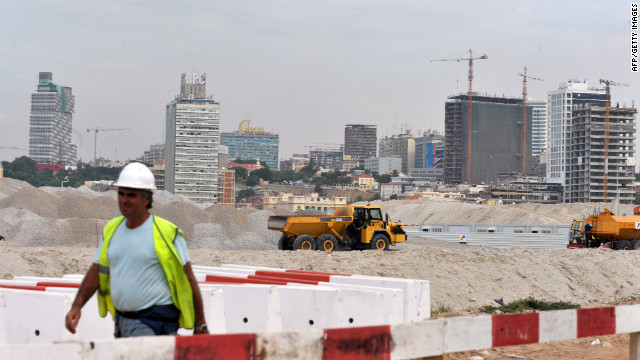 Angola has embarked on a major reconstruction program following the end of a 27-year vicious civil war in 2002. The oil-rich country holds general elections Friday.
Angola has embarked on a major reconstruction program following the end of a 27-year vicious civil war in 2002. The oil-rich country holds general elections Friday.
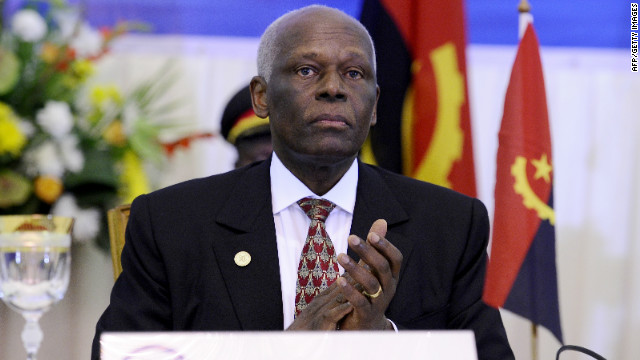 Angolan President Jose Eduardo dos Santos, 70, has been in power since 1979. Analysts expect his party, MPLA, to win Friday's elections.
Angolan President Jose Eduardo dos Santos, 70, has been in power since 1979. Analysts expect his party, MPLA, to win Friday's elections.
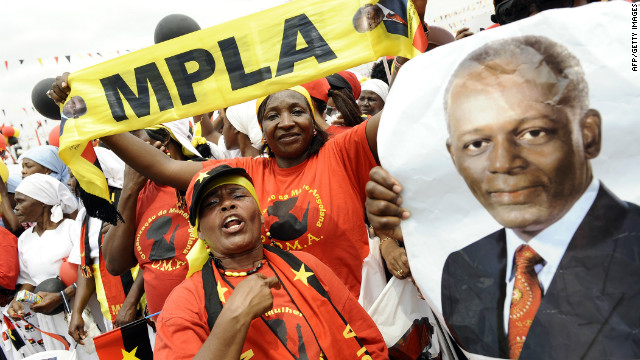 MPLA supporters attend Wednesday the final rally of President dos Santos in Kilamba Kaixi on the outskirts of Luanda, Angola's capital.
MPLA supporters attend Wednesday the final rally of President dos Santos in Kilamba Kaixi on the outskirts of Luanda, Angola's capital.
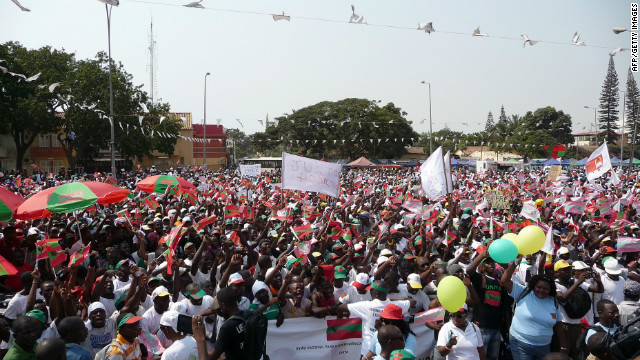 Thousands of Angolans take part in a demonstration in Luanda organized by the main opposition party, UNITA, to ask for free and fair elections on May 19, 2012.
Thousands of Angolans take part in a demonstration in Luanda organized by the main opposition party, UNITA, to ask for free and fair elections on May 19, 2012.
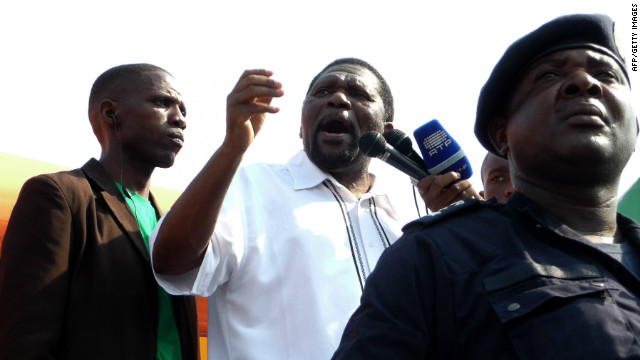 UNITA leader Isaias Samakuva (center), delivers a speech during the May 19 demonstration. The opposition has repeatedly expressed concerns about the electoral process.
UNITA leader Isaias Samakuva (center), delivers a speech during the May 19 demonstration. The opposition has repeatedly expressed concerns about the electoral process.
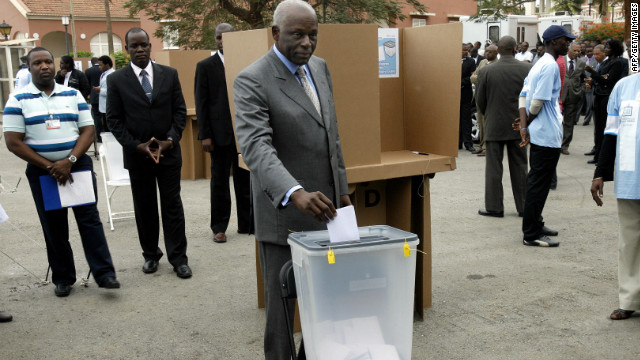 Dos Santos casts his ballot on September 05, 2008, at the polling station behind the presidential palace in Luanda. MPLA won the last elections with a landslide 82% of the vote.
Dos Santos casts his ballot on September 05, 2008, at the polling station behind the presidential palace in Luanda. MPLA won the last elections with a landslide 82% of the vote.
 Resource-rich Angola is the second-biggest oil producer in sub-Saharan Africa, turning out more than 1.9 million barrels per day.
Resource-rich Angola is the second-biggest oil producer in sub-Saharan Africa, turning out more than 1.9 million barrels per day.
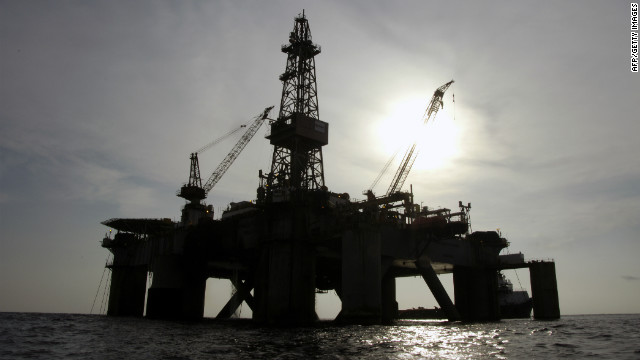 Thanks to its oil reserves, the country has posted impressive economic growth after the end of the war. It is currently the third-biggest economy in sub-Saharan Africa, after South Africa and Nigeria.
Thanks to its oil reserves, the country has posted impressive economic growth after the end of the war. It is currently the third-biggest economy in sub-Saharan Africa, after South Africa and Nigeria.
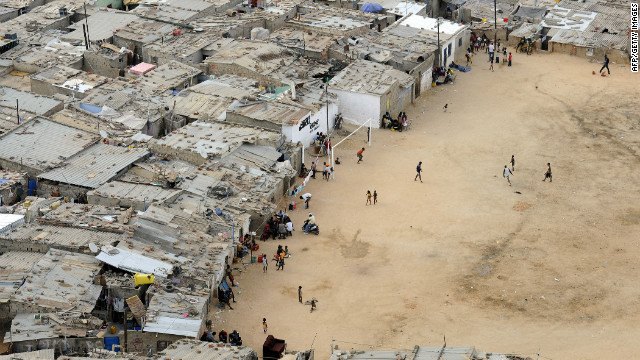 But despite the progress made since 2002, Angola remains one of the most unequal societies in the world. In Luanda, millions of people live in crowded shantytowns, like the Boa Vista slum (pictured), in squalid conditions.
But despite the progress made since 2002, Angola remains one of the most unequal societies in the world. In Luanda, millions of people live in crowded shantytowns, like the Boa Vista slum (pictured), in squalid conditions.
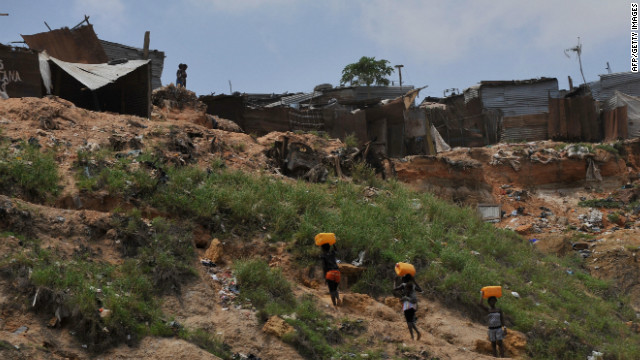 Angola, which has a population of some 18 million people, ranks 148th out of 187 countries in the U.N.'s Human Development Index.
Angola, which has a population of some 18 million people, ranks 148th out of 187 countries in the U.N.'s Human Development Index. 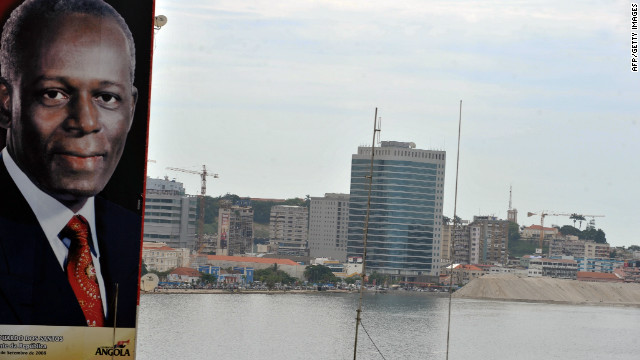 A large portrait of the Angolan President is seen in the center of Luanda on January 30, 2010. The Angolan capital was last year named the world's most expensive city for expats.
A large portrait of the Angolan President is seen in the center of Luanda on January 30, 2010. The Angolan capital was last year named the world's most expensive city for expats.
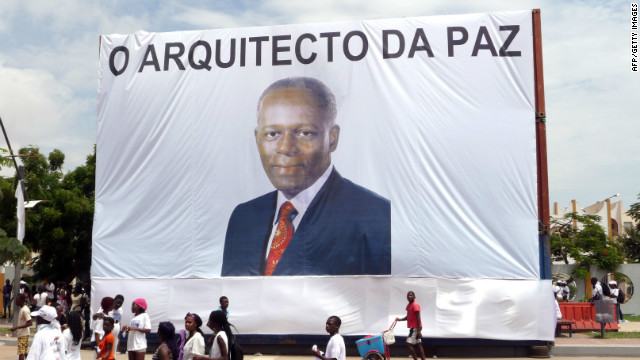 Earlier this year, Angola celebrated 10 years of the end of its civil war. Here, Luanda residents walk in front of a giant portrait of President dos Santos, with text reading "The Architect of Peace" on April 4, 2012.
Earlier this year, Angola celebrated 10 years of the end of its civil war. Here, Luanda residents walk in front of a giant portrait of President dos Santos, with text reading "The Architect of Peace" on April 4, 2012.
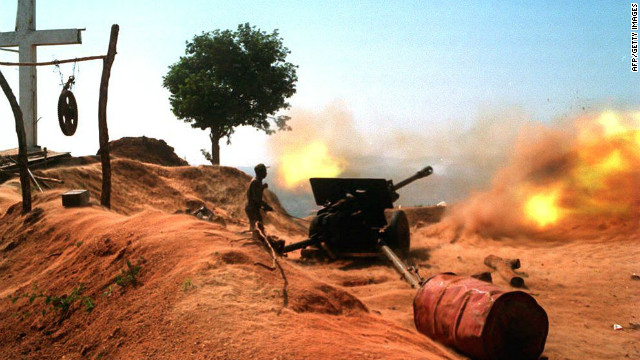 Angola was gripped by a brutal civil war for 27 years that led to the death of up to half a million people, according to the U.N., and also left 15.000 landmines behind.
Angola was gripped by a brutal civil war for 27 years that led to the death of up to half a million people, according to the U.N., and also left 15.000 landmines behind.
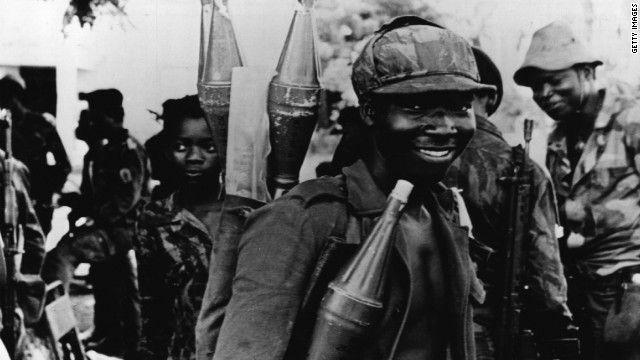 After Portugal's decision to cede power in the African country in the mid-1970s, pro-U.S. UNITA and MPLA, backed by the Soviet Union and Cuba, fought a proxy Cold War for control of the country and its vast resources.
After Portugal's decision to cede power in the African country in the mid-1970s, pro-U.S. UNITA and MPLA, backed by the Soviet Union and Cuba, fought a proxy Cold War for control of the country and its vast resources.
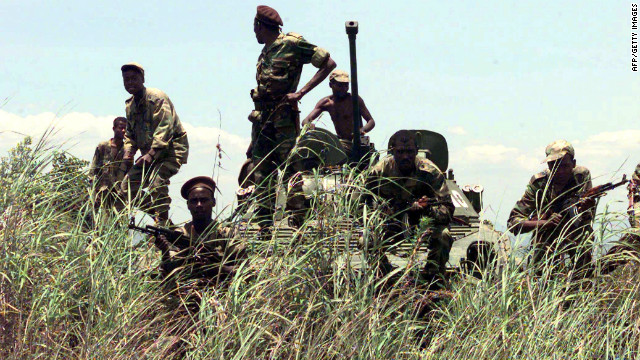 The war ended officially in 2002 when a peace deal was signed following the death of UNITA leader Jonas Savimbi.
The war ended officially in 2002 when a peace deal was signed following the death of UNITA leader Jonas Savimbi.
HIDE CAPTION
Angola's construction boom
President Jose Eduardo dos Santos
Support for MPLA
UNITA demonstration
Opposition leader Isaias Samakuva
2008 elections
Oil boom
Oil boom
Rich-poor divide
Rich-poor divide
Living in Luanda
"The Architect of Peace"
Vicious conflict
Vicious conflict
Vicious conflict
<<
<















>
>>
STORY HIGHLIGHTS
- Oil-rich Angola is holding its second peacetime elections on Friday
- The country has experienced strong growth in the years after the end of its civil war
- Resource-rich countries with little political accountability have trouble converting resources into development
- Business profitability among the poor is constrained by lack of education and health services
Editor's note: Arne Wiig is a Senior Researcher at the Chr. Michelsen Institute (CMI) and coordinator for its research cluster "Poverty Dynamics. He has undertaken long−term fieldwork in Angola, Namibia and Bangladesh. Ivar Kolstad is Research Director at CMI, focusing on poverty dynamics, natural resources and development and corporate social responsibility.
(CNN) -- Ten years after the end of its civil war, Angola, which is heading to the polls Friday, has been transformed into a regional African power with a strong economy, but poverty is still widespread.
Angola experienced double digit growth in GDP annually in the period 2002-2008. In the last five of these years, average annual growth was at 17%, which more than doubled the size of the economy. The country is the second largest oil producer in sub-Saharan Africa, and the third biggest economy, after South Africa and Nigeria.
Do these tremendous growth rates mean that Angola has escaped the so-called resource curse, where oil resources are detrimental to growth? Is Angola likely to continue growing at these fast rates, and perhaps catch up to the largest economies in the region in a few years' time? Is Angola a success in terms of development and poverty reduction?
It is not uncommon for countries that come out of a civil war to grow at very high rates. The growth seen in the period 2002-2008 may thus reflect the end of the civil war in 2002.
Read related: Post-war generation emerges as Angola votes
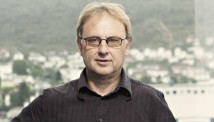
Arne Wiig
If there is a tendency to blame all that is wrong in Angola on its war legacy, perhaps the end of the war should be credited for things that have been going well?
It is always problematic to speculate about future growth rates. After 2009, growth has dropped to around 3% per year and projections for the coming years are in the range 5-8%. There are many reasons for this significant drop, the financial crisis and oil price development are part of the explanation.
But in the longer perspective, there may be more fundamental structural challenges to Angolan growth and development. In particular, research shows that resource-rich countries with little political accountability have trouble converting resources into development.
Angola scores still low on governance indicators, and the coming elections seem unlikely to challenge the over 30-year-long reign of President Jose Eduardo dos Santos.

Ivar Kolstad
Watch: Angola's economic potential
The fact the Angolan economy is the most concentrated in sub-Saharan Africa also makes growth vulnerable. The profitability of the oil sector renders diversification difficult in any economy.
But is the Angolan government really trying to diversify?
An important question is how government reliance on oil rents affects political incentives to diversify the economy. Business environment indicators for the country remain poor, while investment is hampered by a lack of education and institutional challenges.
Do the poor care about the overall growth rate of the Angolan economy? Experience shows that growth reduces poverty less in countries with high initial inequality. And oil-driven growth in a country with low political accountability is susceptible to wealth concentration rather than redistribution. Employment in the oil sector is typically also too limited to produce widespread economic opportunities.
Read also: Ghana's oil discovery: blessing or curse?
We really don't know too much about the situation of the poor in Angola today. The last real census in the country was conducted in 1970. The last figures on poverty are from 2000, putting the proportion of people living on less than $1.25 a day at 54%. Angola ranks as 148 out of 187 countries on the Human Development index.
Based on a household sample, INE estimated a poverty rate of 37% in 2008. However, it is difficult to assess how the poverty line was constructed. As data is not directly comparable to previous studies, it is also problematic to analyze development over time. In spite of this, the President claims that the poverty rate has been reduced from 70 to 37% from 2002 to 2008.
A census is due to be held next year. Interestingly, but perhaps not surprisingly, it takes place after the coming elections.
Some data of a more limited nature do provide a window onto the situation of the poor in Angola. In 2010, the Angolan NGO Development Workshop and the Chr. Michelsen Institute conducted a survey of microcredit clients in Luanda.
Results suggest that business profitability among the poor is constrained by a lack of education and health and by corruption. This indicates that the factors that restrain dynamism in non-oil segments of the Angolan economy, also act as constraints on the very survival of the urban poor.
Without structural and political reforms of these constraints, it is hard to believe that an election in and of itself will change the lives of the poor.
The opinions expressed in this commentary are solely those of Arne Wiig and Ivar Kolstad.
Wednesday, October 3, 2012
African Union troops bolster gains in Somali port
MOGADISHU,
Oct 3 – African Union troops and allied Somali forces bolstered
positions on Wednesday in the former Islamist bastion of Kismayu,
residents said, a day after entering the Somali port city amid heavy
explosions.
Wary shopkeepers, who had shut down business since
Al-Qaeda linked Shabaab abandoned the city on Saturday, reopened for the
first time, as patrols of Somali and AU forces moved through the town.
Kenya: Police On Red Terror Alert After Kismayu Raid
Police said Tuesday they were on a high alert following intelligence
reports of imminent terror attacks in the country since the Kenya
Defense Forces entered Kismayu port in Somalia.
Police Spokesman Eric Kiraithe announced that security forces had increased surveillance and urged the public to be on the look out for people with ulterior motives.
"We have intelligence reports in respect to terrorist threats from Al Shabaab and their sympathisers since KDF entered Kismayu," Kiraithe told a news conference Tuesday.
 As a result, he said, "security forces in the country have heightened their surveillance to ensure the country is safe."
As a result, he said, "security forces in the country have heightened their surveillance to ensure the country is safe."
He said intelligence reports had shown that Al Shabaab was actively recruiting women to carry out attacks, including acting as suicide bombers.
Police Spokesman Eric Kiraithe announced that security forces had increased surveillance and urged the public to be on the look out for people with ulterior motives.
"We have intelligence reports in respect to terrorist threats from Al Shabaab and their sympathisers since KDF entered Kismayu," Kiraithe told a news conference Tuesday.
He said intelligence reports had shown that Al Shabaab was actively recruiting women to carry out attacks, including acting as suicide bombers.
Subscribe to:
Comments (Atom)




